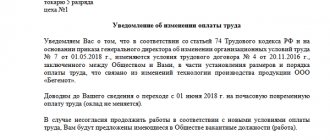In what cases is a salary change made?
Information about an employee’s salary is one of the important components of the employment agreement.
It should not have double interpretation. In this case, the employee can receive his remuneration for the time actually worked or for the number of units of output. If an employee is paid a salary, this means that if he works a set amount of time every month, he will receive the same amount.
The administration may increase salaries. This occurs when individual legislative acts come into force, or on the initiative of the administration itself, subject to the availability of financial opportunities.
The most common situation for salary changes is when it is set at the minimum wage. As soon as a decision is made at the legislative level to increase this indicator, the administration is also obliged to revise the employee’s earnings upward.
Otherwise, the company will be held liable for failure to comply with the requirements of the law. It is not allowed if, with a typical working day, the employee’s payment will be less than the minimum wage.
In addition, the Constitutional Court is obliged by business entities to index the employee’s earnings annually.
The rate of inflation, the rate of growth in consumer prices, etc. can be used as a coefficient. Attention: thus, the salary must be increased by at least the established coefficient.
Commercial organizations can choose the coefficient for themselves; budgetary institutions use the approved inflation rate. Business entities can voluntarily, if they have the financial capacity, index the earnings of their employees.
Design rules
There are no special requirements for the execution of the order, as well as for its content: it can be written on an ordinary piece of paper or on the company’s letterhead, either by hand or in printed form.
The only thing that must be observed is the presence of “live” autographs of the director of the organization, all persons mentioned in the order, as well as the employees responsible for its execution.
If the number of employees who are affected by the wage increase is large enough, then to record the fact that they have read the order, a separate document called “order familiarization sheet” should be generated.
It is not necessary to certify the form using the seal or stamp of the enterprise, since since 2021 legal entities have the right to use stamped products only if this rule is enshrined in the internal regulations of the company.
The order is usually issued in a single copy and, after issuance, is recorded in the company's local internal documentation journal.
How to commit a change
If a decision is made to change an employee’s salary, it must be recorded in several documents at once:
- An order to change the salary is the main document for the enterprise, which states which employee and what salary should be set. Here it is determined from what date this change begins to take effect. The order may also contain instructions to change other documents.
- Staffing table - the document indicates the name and number of employee positions, as well as the salaries associated with them. In the event that an employee’s salary changes, the salary must also be changed in the staffing table. This step can be carried out by ordering changes, or by developing and introducing a new staffing table (if a large number of salaries are changing).
- Employment agreement with an employee - the Labor Code determines that the amount of an employee’s salary is necessarily fixed in the employment agreement with him. If the salary changes, then it is best to draw up an additional agreement to the employment contract on the salary change. Thanks to this document, the old provision of the contract changes to a new one.
What is the difference between salary and salary?
At their core, these two concepts are close and quite similar - they both relate to the economic component of the employee’s labor. But there are also significant differences between them.
Salary is considered to be the unchanged base part of the salary, which is prescribed in the employment contract or an additional agreement to it.
Wages are a whole series of various accruals: salary, allowances for hazardous production, percentage of sales, bonuses, bonuses, etc. minus insurance payments to extra-budgetary funds. When wages increase, all parts of wages increase simultaneously.
Grounds for issuing an order
The reasons why an order to change the salary may be issued can be divided into two groups - at the initiative of the employer or by force of law.
The law states that wages must be expressed as a fixed amount, which the employee will receive if he works in full for the month. Its size in this case should also not be less than the minimum wage.
Therefore, if the law establishes a new minimum wage, the employer is obliged to adjust existing salaries to its level - they should not be less than the minimum amount.
In addition, the law or internal regulations may establish the need for annual salary indexation. It must be carried out on the value of inflation for the previous year or the increase in consumer prices. Then it is necessary to indicate Art. 134 of the Labor Code, as well as the clause of the Regulations on payment, or a separate Regulation on indexation.
Attention: if the administration wants to encourage an employee, it can do this by increasing the salary. The step for this should be a memo from the immediate supervisor. The manager must consider it and put down his resolution.
If the decision to increase the salary is positive, then when drawing up the order, this memo will be used as a basis.
What is the difference between a salary increase and indexation?
A salary increase may apply to a specific group of employees, is solely the will of the employer and always has an individual numerical value. In other words, the head of the enterprise has the right, at his own discretion or based on the recommendations of the heads of structural divisions, to determine who, for what and by what amount to increase wages.
As for indexation, the situation here is somewhat different - the norm for it is prescribed in the legislation of the Russian Federation, i.e. every employer is obliged to carry it out.
During indexation, the salary portion is subject to increase, while the amount of the increase is always fixed and applies to all employees of the enterprise. The purpose of indexation is to change wages in order to ensure the purchasing power of workers at an acceptable level, since it is known that due to inflationary processes it has a steady downward trend.
How to place an order correctly
The law does not establish any special form for this document. As a rule, for this order, a standard form of the organization is used, on which all the details have already been entered, or the order is drawn up in any form.
If an order is drawn up without using a form, you first need to fill out its header. At the top of the sheet, the full name of the business entity, its address, and registration codes are written down. It is allowed that bank details are also indicated in the header.
Next, in the middle of the sheet, you must indicate the name of the document - “Order”, and put down its serial number. Under it, the document is registered in the journal of orders for the enterprise.
Under the title of the document, it is customary to indicate its short name - for example, “On an increase in official salary.”
The next line must contain the date the order was drawn up and the place (name of the locality).
The text of the order must begin with an introduction. It must indicate the reason why the document is being issued. For example, if there was an increase in the minimum wage, then here you can write: “Due to a change in the size of the minimum wage from <date>.”
Next, the document reflects the administrative part, which follows the word “I ORDER” and includes the following information:
- Order to approve the amount of remuneration for the employee (the position and full name must be indicated). At the same time, this part must necessarily reflect the new size and the definition of the period from which it will be valid.
- An order to the accounting department accountant to calculate salaries according to the new amounts.
- An order to HR specialists to correct the information in the company’s staffing table (make changes or develop a new staffing table).
- Instruct the HR department specialists to prepare additional agreements with employees for new wage amounts.
- Establish an official in the company whose responsibilities will include monitoring the implementation of this order.
The basis for drawing up the order are considered to be official and memos that were previously sent to the director. This order must be signed only by the head of the organization.
After its endorsement, all persons mentioned in this order must affix their signatures as confirmation of the fact by familiarizing themselves with its contents. The date of review is indicated here.
Who writes the order to increase wages?
Any employee of an enterprise whose job functions include the preparation of administrative documentation or who is personally appointed to perform this duty by the manager can draw up an order to increase wages. Usually this:
- HR department employee
- legal adviser
- or secretary of the organization.
In any case, after drawing up, the order to increase wages should be submitted to the director for approval and signature. Without his autograph, this document will not acquire legal force.
Opportunities to increase or reduce salary
The wages of employees of a budgetary enterprise are prescribed in the provisions of the labor or collective agreement.
A salary reduction is possible only if the terms of the employment contract are revised during negotiations between the employee and the director of the organization (Article 72 of the Labor Code of the Russian Federation).
You can increase the permanent part of your salary for the following reasons:
- the desire to bring wages in line with certain economic indicators;
- incentives for one or more employees;
- introducing an additional measure of staff motivation.
The director of the enterprise can change the remuneration of employees for work upward as many times as he likes, even every month; there are no restrictions for this action. In most situations, the company's management takes as a basis the rules prescribed in local documentation, which stipulate the reasons and dates for the increase.
In any case, an order must be issued. For salary increases and decreases, they are slightly different. When cutting a fixed portion of your salary, there are many more steps required.
It is important to remember that when drawing up a sample order to change the salary, changes must also be made to the staffing table. It is enough to include such a clause in the first document.
The procedures for salary increases and wage indexation should not be confused. The main difference is that a company director can increase the salary of one employee or a group of people by different amounts and at any time (without allowing discrimination in wages). Indexation applies to all personnel of the organization, and after it the salary increases by the same percentage for all employees.
Salary reduction
Staff are notified two months in advance of the upcoming reduction in the fixed part of their salary.
The responsible employee draws up the following documents:
- notification;
- additional agreement;
- order.
A notice is sent to all employees whose earnings will be reduced. After a 2-month period, the employer has the right to draw up an additional agreement to the employment contract. After the employee signs it, the director of the organization must draw up an order indicating the planned changes and their reasons, as well as a list of employees.
There is no unified notification form established by law, therefore it is allowed to draw up a document in any form. However, you must specify:
- name of the enterprise;
- exact legal address of the organization;
- total number of personnel;
- details of company managers;
- information about the upcoming salary reduction;
- full initials of the employee or group of people affected by the changes;
- reasons for salary reduction;
- possible consequences for the organization if wages are not reduced;
- director's signature and seal.
The notice is given to each employee personally.
IMPORTANT!
The employer must be notified of the salary reduction against signature within a two-month period before the action is implemented. If the employer is an individual, the period is reduced to 2 weeks, and if a religious organization - to one week (Article 344, Labor Code of the Russian Federation).
If the employee refuses to accept the new conditions, the director of the enterprise is obliged to offer him other options in writing, for example:
- Transfer to a lower position.
- Another vacancy corresponding to the employee’s qualifications.
- A position with a lower salary that is acceptable for the employee's health condition.
The director of the company also provides alternative jobs to the employee upon signature. If an agreement is reached, an addition to the employment contract and an order to change the salary are drawn up.









